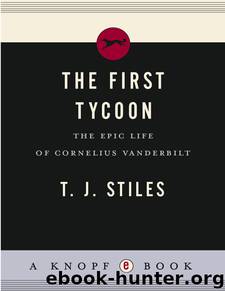The First Tycoon by T.J. Stiles

Author:T.J. Stiles [Stiles, T. J.]
Language: eng
Format: epub
ISBN: 978-0-307-27155-6
Publisher: Knopf Doubleday Publishing Group
Published: 2009-02-11T16:00:00+00:00
MANY MYSTERIES SURROUND the Harlem corner. How much stock did Vanderbilt really keep in the end? How much did he make? Who were his collaborators? Perhaps most important, who were his enemies? The councilmen and aldermen? In the last case, this was petty individual graft. The famously corrupt Tweed Ring did not yet exist. Nor was it a Tammany Hall operation. Contrary to historical myth, Tammany had never been an all-powerful machine, especially not now, when it comprised only one wing of the Democratic Party41
Historian Mark Wahlgren Summers convincingly refutes the long-held idea that the Civil War gave rise to “exceptional rascality.” It was not corruption that was new, he writes, but the corruption issue—a fever for reform that would grow with the coming of peace. As we've seen, graft arrived on the American scene long before 1861; as Summers notes, the “argot of corruption,” with such terms as “borers,” “strikers,” and “dummies,” first emerged in the antebellum years. The source might be traced back to the Jacksonian revolution in politics, with the rise of professional politicians who treated elections and officeholding as a business. Some were simply greedy, but even the most public-spirited needed money to fund campaigns, partisan newspapers, and party rallies. As Tweed ascended to power in the months ahead, he would not pioneer graft, but rationalize it to serve the purpose of governing the decentralized, anarchic city. In that sense, the Common Council's bear raid on Harlem represented a transitional moment in New York's rich history of corruption—a frenzy of profiteering before the rise of the more systematic (but equally greedy) Tweed.42
A more personal mystery surrounds Daniel Drew. The banker Henry Clews would later write in his influential memoir (Twenty-eight Years in Wall Street, updated later as Fifty Years in Wall Street) that “Drew was one of the great bears in this deal with the aldermen.” Clews and other Wall Street men of the 1860s depicted Drew as Vanderbilt's natural rival—the bear who fought the bull, a skulking fiend who undercut stock prices and refused to fulfill his contracts when he lost money43 Unfortunately, Clews was a wildly unreliable rumormonger with a taste for the most colorful version of any story; his oft-quoted tales are mostly worthless as historical evidence. More than that, this dark picture of Drew was projected through the lens of events yet to occur. In 1860, by contrast, R. G. Dun & Co. had made a more nuanced report: “His stock firm stands high at the Board. Drew is pretty well liked & not very grasping in his disposition, but takes care that he gets his own. Altho he is [responsible], his contracts would be better interpreted in writing.”44 He was a bit slippery, then, but not dishonorable—quite popular, in fact, and well respected. True, he had a taste for short-selling (his inside trading in Erie stock had come to light as early as 1857), but that did not make him Vanderbilt's enemy. No evidence exists to indicate a departure from their long years of close cooperation in business operations and speculation, let alone their friendship.
Download
This site does not store any files on its server. We only index and link to content provided by other sites. Please contact the content providers to delete copyright contents if any and email us, we'll remove relevant links or contents immediately.
Hit Refresh by Satya Nadella(9040)
When Breath Becomes Air by Paul Kalanithi(8333)
The Girl Without a Voice by Casey Watson(7824)
A Court of Wings and Ruin by Sarah J. Maas(7653)
Do No Harm Stories of Life, Death and Brain Surgery by Henry Marsh(6891)
Shoe Dog by Phil Knight(5147)
Hunger by Roxane Gay(4869)
The Rules Do Not Apply by Ariel Levy(4866)
A Higher Loyalty: Truth, Lies, and Leadership by James Comey(4851)
Tuesdays with Morrie by Mitch Albom(4695)
Everything Happens for a Reason by Kate Bowler(4680)
The Immortal Life of Henrietta Lacks by Rebecca Skloot(4527)
Millionaire: The Philanderer, Gambler, and Duelist Who Invented Modern Finance by Janet Gleeson(4386)
How to Change Your Mind by Michael Pollan(4292)
All Creatures Great and Small by James Herriot(4233)
The Money Culture by Michael Lewis(4083)
Man and His Symbols by Carl Gustav Jung(4070)
Elon Musk by Ashlee Vance(4033)
Tokyo Vice: An American Reporter on the Police Beat in Japan by Jake Adelstein(3937)
